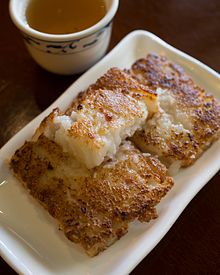Daikon cake
 |
|
| Alternative names | radish cake |
|---|---|
| Course | Yum cha |
| Place of origin | Southern China |
| Region or state | Chinese-speaking areas |
| Main ingredients | shredded radish (typically Chinese radish), plain rice flour |
| Variations | Fried and steamed |
| |
|
| Turnip cake | |||||||||||
| Chinese name | |||||||||||
|---|---|---|---|---|---|---|---|---|---|---|---|
| Traditional Chinese | |||||||||||
| Simplified Chinese | |||||||||||
| Hanyu Pinyin | luóbo gāo | ||||||||||
| Literal meaning | radish cake | ||||||||||
|
|||||||||||
| Alternative Chinese name | |||||||||||
| Chinese | 菜頭粿 | ||||||||||
|
|||||||||||
| Thai name | |||||||||||
| Thai | ขนมผักกาด [kʰā.nǒm pʰàk kàːt] | ||||||||||
| RTGS | khanom phak kat | ||||||||||
| Transcriptions | |
|---|---|
| Standard Mandarin | |
| Hanyu Pinyin | luóbo gāo |
| Yue: Cantonese | |
| Jyutping | lo4 baak6 gou1 |
| Transcriptions | |
|---|---|
| Southern Min | |
| Hokkien POJ | chhài-thâu-kóe, chhài-thâu-ké |
Turnip cake is a Chinese dim sum dish made of shredded radish (typically Chinese radish) and plain rice flour. The less commonly used radish cake is a more accurate name, in that Western-style turnips are not used in the dish; it is traditionally called carrot cake in Singapore. It is commonly served in Cantonese yum cha and is usually cut into rectangular slices and sometimes pan-fried before serving. Each pan-fried cake has a thin crunchy layer on the outside from frying, and soft on the inside. The non-fried version is soft overall. It is one of the standard dishes found in the dim sum cuisine of Hong Kong and China as well as overseas Chinatown restaurants. It is also commonly eaten during Chinese New Year, since radish (菜頭, chhài-thâu) is a homophone for "good fortune" (好彩頭, hó-chhái-thâu) in Hokkien. In Taiwan, turnip cake is also commonly eaten as part of a breakfast.
To prepare a turnip cake, roots of Chinese radish are first shredded. Chinese radish, either the white-and-green variety or the all-white variety, is one of the key ingredients since it makes up a large portion of the cake. The other key ingredients are water and rice flour. Corn starch is sometimes added as it aids in binding the cake together, especially when a large number of additional ingredients (see list below) are added. The ingredients are stirred together until combined.
Additional ingredients that provide umami flavouring can be also added. They include diced or minced pieces of:
These flavoring ingredients may first be stir-fried before being added to the radish and flour/starch mixture. Somewhat more luxurious cakes will add larger amounts of these ingredients directly to the mixture. Cheaper variants, especially those sold in dim sum restaurants will often just have a sprinkling on the top, to keep costs down.
...
Wikipedia
